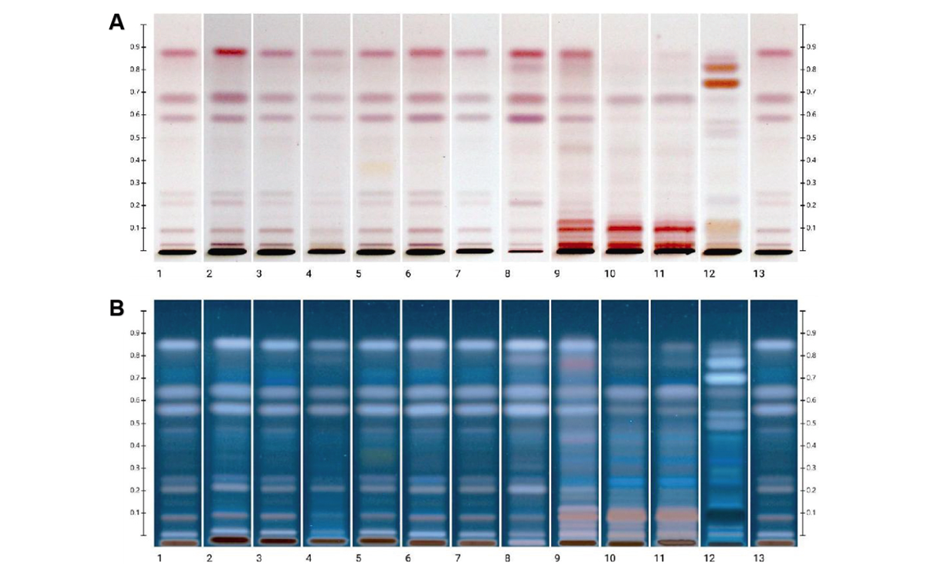Mr. Aniket Jadhav, an application chemist working under the guidance of Mr. Akshay Charegaonkar, Managing Director, is employed at Anchrom Enterprises Pvt. Ltd. in Mumbai, India. The company specializes in instrumental planar chromatography and is dedicated to the development of innovative quantitative and regulatory-compliant analytical methods for various sectors including pharmaceutical formulations, APIs, herbal products, food products, organic intermediates, dyes, and more. Mr. Jadhav utilizes the advantages of HPTLC due to its attributes as a rapid, easy, cost-effective, and versatile "visible chromatography" technique. HPTLC is distinguished by its risk-free nature, allowing for multiple detections without the need for repeated chromatography.
Introduction
Withania somnifera, commonly known as Ashwagandha, is a versatile herb deeply rooted in traditional and modern herbal medicine. This herb, belonging to the Solanaceae family, holds a significant place in the cultures of India and beyond. Ashwagandha is recognized for its potential therapeutic properties, including adaptogenic, anti-inflammatory, antioxidant, and stress-reducing effects. Moreover, it has gained prominence in the pharmaceutical and dietary supplement industries due to its various health benefits. The quality and authenticity of Ashwagandha formulations can be influenced by several factors, including the source of cultivation, processing methods, and storage conditions. This valuable herb is, however, vulnerable to potential adulteration and contamination, which can compromise its efficacy and safety. To ensure the purity and integrity of Ashwagandha formulations, it is essential to develop analytical methods capable of detecting adulteration in these products. HPTLC has emerged as a valuable tool in this regard, offering a costeffective and efficient means of separating and analyzing complex mixtures of chemical components.
HPTLC offers a rapid, cost-effective, and efficient method for distinguishing pure Ashwagandha BRM from potential adulterants in Ashwagandha products available in the market and contributing to the overall integrity and reliability of herbal products in the industry. By analyzing multiple samples simultaneously on a single plate, this technique saves time and resources while minimizing solvent consumption and waste production. It serves as a vital quality control measure, ensuring the authenticity and purity of Ashwagandha formulations, thereby enhances consumer trust and upholds the herbal industry's reputation.
Standard solutions
1.0 g of Withania somnifera root (BRM) is dissolved in 10 mL methanol.
Sample preparation
1.0 g of Withania somnifera marketed formulations are dissolved in 10 mL of methanol. The samples were vortexed thoroughly and centrifuged at 2000 rpm for 5 min. After centrifugation, the supernatant is collected and used for the application.
Chromatogram layer
HPTLC plates silica gel 60 F254 (Merck), 20 x 10 cm are used.
Sample application
2.0 and 10.0 μL of sample solutions and 10.0 μL of standard solutions are applied as bands with the Automatic TLC Sampler (ATS 4), 13 tracks, band length 8.0 mm, distance from the left edge 15.0 mm, track distance 13.4 mm, distance from the lower edge 8.0 mm.
Chromatography
Plates are developed in the ADC 2 with chamber saturation (with filter paper) for 20 min and after activation at 33% relative humidity for 10 min using a saturated solution of magnesium chloride, development with toluene – ethyl acetate – glacial acetic acid 55:45:3 (V/V) to the migration distance of 70 mm (from the lower edge), followed by drying for 5 min.
Post-chromatographic derivatization
The plate is sprayed with 3 mL of sulfuric acid reagent (180 mL ice-cold methanol are mixed with 20 mL of concentrated sulfuric acid and allowed to cool to room temperature) using the Derivatizer. After spraying, the plate is heated at 110 °C for 3 min using the TLC Plate Heater.
Documentation
Images of the plate are captured with the TLC Visualizer in UV 366 nm and white light after derivatization.
Results and discussion
In the comparison of Withania somnifera root (BRM) with various marketed samples of Withania somnifera (Ashwagandha), several significant observations were made. Firstly, the visible images revealed that the BRM standard exhibited seven intense bands, setting it apart from the other samples. Notably, marketed samples 1, 6, 7, 8, 9, and 10 displayed a similar pattern to the BRM standard, indicating a degree of similarity in their composition. However, marketed samples 9 and 7 exhibited some extra bands at RF 0.37 and RF 0.81, respectively, suggesting potential variations in their chemical profiles. Furthermore, marketed sample 2 displayed two additional bands at RF 0.13 and 0.46, which distinguished it from the others. On the other hand, marketed samples 3 and 4 shared similarity with each other but did not match with the fingerprinting pattern of the BRM. Lastly, marketed sample 5 exhibited a distinct profile compared to the botanical standard, featuring extra bands at RF 0.53, 0.74, and 0.82. These findings suggest variations in chemical composition among the analyzed Ashwagandha samples, emphasizing the importance of precise quality control in herbal product assessment and standardization.

HPTLC fingerprints: in white light (A) and UV 366 nm (B) after derivatization with sulfuric acid reagent; Tracks 1, 7 & 13: Botanical reference material; track 2: sample 1, track 3: sample 6, track 4: sample 8, track 5: sample 9, track 6: sample 10, track 8: sample 7, track 9: sample 2, track 10: sample 3, track 11: sample 4, track 12: sample 5
[1] HPTLC Association - Withania somnifera root
Further information is available on request from the author.
Contact: Mr. Akshay Charegaonkar, A-101, Shree Aniket Apartments, Navghar Road, Mulund East, Mumbai, Maharashtra 400081, India, hptlc@anchrom.in, www.anchrom.in